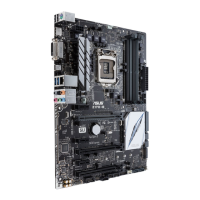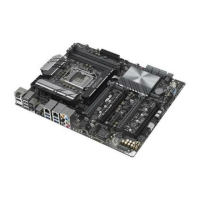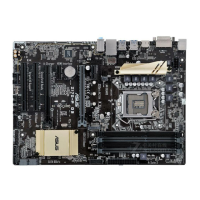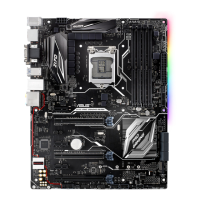Boot from Network Devices [Legacy only]
Allowsyoutoselectthetypeofnetworkdevicesthatyouwanttolaunch.Conguration
options:[Ignore][Legacyonly][UEFIdriverrst]
Boot from Storage Devices [Legacy Only]
Allowsyoutoselectthetypeofstoragedevicesthatyouwanttolaunch.Conguration
options:[Ignore][Legacyonly][UEFIdriverrst]
Boot from PCI-E Expansion Devices [Legacy Only]
AllowsyoutoselectthetypeofPCI-Eexpansiondevicesthatyouwanttolaunch.
Congurationoptions:[Legacyonly][UEFIdriverrst]
2.8.9 Secure Boot
AllowsyoutoconguretheWindows
®
SecureBootsettingsandmanageitskeystoprotect
thesystemfromunauthorizedaccessandmalwaresduringPOST.
OS Type [Windows UEFI mode]
Allowsyoutoselectyourinstalledoperatingsystem.
[WindowsUEFImode] Thisitemallowsyoutoselectyourinstalledoperatingsystem.
ExecutetheMicrosoft
®
SecureBootcheck.Onlyselectthis
optionwhenbootingonWindows
®
UEFImodeorotherMicrosoft
®
SecureBootcompliantOS.
[OtherOS] GettheoptimizedfunctionwhenbootingonWindows
®
non-UEFI
mode.Microsoft
®
SecureBootonlysupportsWindows
®
UEFI
mode.
Key Management
ThisallowsyoutomanagetheSecureBootkeys.
Install Default Secure Boot keys
ThisitemallowsyoutoclearalldefaultSecureBootkeys.
Save Secure Boot Keys
ThisitemallowsyoutosavethePK(PlatformKeys)toaUSBstoragedevice.
PK Management
ThePlatformKey(PK)locksandsecuresthermwarefromanynon-permissible
changes.ThesystemveriesthePKbeforeyoursystementerstheOS.
Set New Key
ThisitemallowsyoutoloadthedownloadedPKfromaUSBstoragedevice.
ThePKlemustbeformattedasaUEFIvariablestructurewithtime-basedauthenticated
variable.
Delete Key
ThisitemallowsyoutodeletethePKfromyoursystem.OncethePKisdeleted,allthe
systemsSecureBootkeyswillnotbeactive.
2-42
Chapter 2: Getting started

